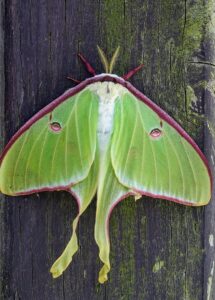Moths: Nature’s quiet wonders
Published 12:03 pm Wednesday, February 21, 2024
|
Getting your Trinity Audio player ready...
|
I never thought of moths as pollinators until recently. Their cousins, the butterfly, get a lot more attention. But moths are vital parts of nature and come in so many varieties. And they are fascinating!
First, a moth is, of course, an insect—an animal with six legs and antennae. Compared to butterflies, both are important pollinators with moths generally flying at night and butterflies flying during the day. Just like bees and butterflies, moths visit flowers to feed on nectar. As they move from flower to flower, they transfer pollen, helping plants reproduce and produce seeds.
So, what flowers get pollinated at night? A favorite native plant, evening primrose, is pollinated by moths as the flowers bloom mostly after dark.
Butterflies and moths start out as eggs, which turn into caterpillars and then finally into moths or butterflies. Both the winged insect and the caterpillar are food to lots of other animals including birds, bats, lizards, frogs and all sorts of creatures.
One way to tell moths and butterflies apart is to look at the antennae, which are feathery on a moth but are thin and wire-like on a butterfly.
Moths have some cool, unique characteristics. To survive in the wild, moths have evolved remarkable camouflage abilities, making them less vulnerable to predators. Some species even mimic the appearance of leaves or twigs to avoid detection. Certain moths can even produce chemical defenses or emit ultrasonic signals to deter predators.
Some have no mouths! Our beautiful luna moth has no mouth and therefore doesn’t eat. Living only a couple of weeks, their sole purpose is mating. How fascinating!
But my favorite moth is the hummingbird moth, or sphinx moth, which flies during the day. Looking and acting like miniature hummingbirds, they start out as the oft-dreaded hornworm caterpillar. After I learned they turn into beautiful pollinators, I regretted every single time I squished one as they devoured my tomato plants. Now, I plant extra tomato plants just for them!
With habitat destruction, moths need our help. But what can we do? Start by learning about them to better understand their important role in nature better. When you are outside, take a closer look at moths. Observe their patterns and learn their names.
Make plans to go hear Jim McCormac, a moth expert, speaking at the Gardening for Life Project event on March 30 in Columbus. If you didn’t get a ticket, get on the waitlist by going to their website.
You can plant native flowers that attract moths. Think buttonbush, serviceberries, violets and, of course, evening primrose. All of these attract moths and can be host plants where they can lay their eggs to reproduce.
And please, please turn off your outdoor lights at night or put them on motion detectors so they are on for only short periods. Artificial night lighting poses a hazard to moths, birds, bats and other nocturnal animals and can prevent proper navigation, food hunting and even reproduction. That’s an easy way to help them!
Although moths may not grab our attention like other charismatic species, they quietly play a vital role in nature. The next time you see a moth, give it a nod—it’s diligently working to keep our world healthy!

Did you know luna moths have no mouths?
Loti Woods is a founder of Champions for Wildlife, a nonprofit organization whose mission is to inspire and empower our kids, using art and education, to be champions for wildlife. To learn more, visit championsforwildlife.org.


